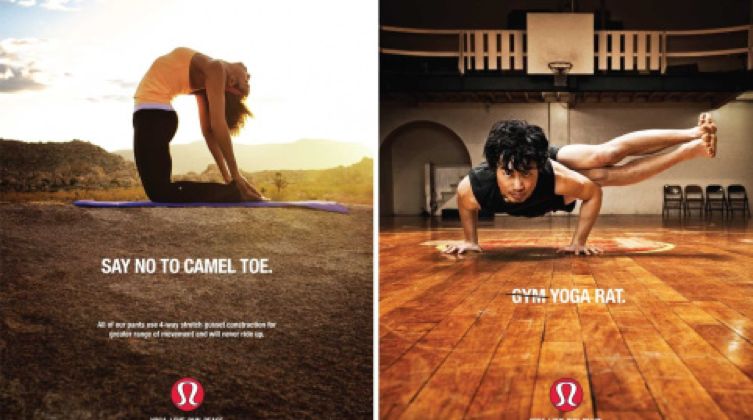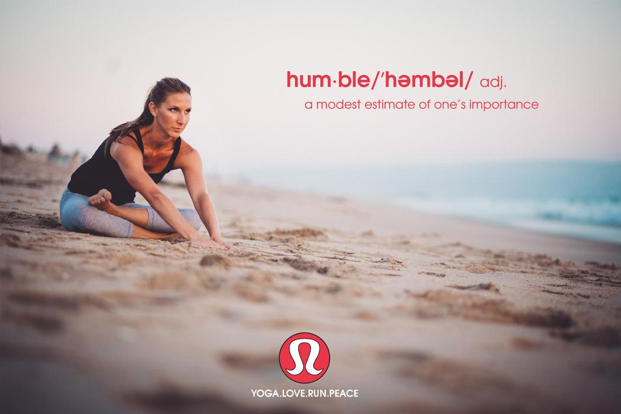
The Lotus Pose
Lululemon is an a clothing company that is well known for its range of “Athleisure” clothing. The company was founded by Chip Wilson with the intent to create a culture of mindfulness and inclusion centered around the practices and beliefs in yoga practice. However, within its advertising practices it can be noted that the majority of models and employees are composed of the white majority and feature thin and toned body types. LuluLemon has created a culture that upholds and supports white hegemonic norms concerning femininity specifically; body shape and size.

The Lululemon Manifesto
Lululemon prides itself on the idea promoting positive ideas that seem inclusive to all people. At a certain point in time– these bags were seen almost everywhere. Their manifesto embodies the westernized version of yoga that is so present in today’s media. The overly positive way that Lululemon presents itself as a brand on their bag for athletic and yoga wear conflicts with their overall ways of advertising their clothes to people of all races, shapes and sizes.

Although the practice originated in India, when most people think of yoga, it is associated with upper-middle class white women. Most of the bodies you see in advertisements are all of thin, white women. This extends to representation in other media–such as television and film. In all these forms of media we are all subject to seeing the common, thin white woman practicing yoga in order to relieve the ‘stress’ from their lives. In turn, framing people to believe that this body shape is the only one able to do these types of yoga poses. These ads and images cater and target to a specific and profitable race and body type. As capitalism is a driving force in shaping sports at every level (Brannon & Messner, 2013), Yoga athleisure is not cheap either. Their prices average at 98$ per pair of yoga pants. Westernized Yoga, along with their active wear, caters to a demographic where they have more money to spend on classes and active wear.

Even though this brand is primarily toward women, this advertisement caters to the male gaze. It shows that women in sport have to look a certain way and emphasize their femininity. It contributes to the idea that women participate in sport and activities to make themselves look good for the gaze of other people and not themselves. Yoga is already sexualized– through the ‘flexibility’ people gain from the practice, and the pants themselves, which have notable been banned in high school across the nation. As coverage of women’s athleticism has highlighted femininity and sexist tones, (Cooky, Messner, & Hextrum, 2013) Advertising from brands like Lululemon has contributed to this continued narrative.

In this ad we can see a strong difference in advertising between men and women. Men are marketed to in a way that supports their strength and physical endurance. Women on the other hand are marketed to in a way that upholds the idea they must be beautiful and flawless. Camel toe being the flaw of yoga pants that do not fit properly. Camel toe has been labeled as unattractive or commonly seen as a gag in the media.

Here Lululemon advertising again comments on the shape of people who practice yoga. Instead of comfortable workout clothes that fit all shapes and sizes, the company sells and promotes clothing that is tailored and tight to create the “yoga body” silhouette. The yoga body can be considered streamlined, toned, thin, and predominately featured on and through white women. Former CEO of Lululemon, Chip Wilson, was under fire in 2013 for making comments about women’s body types. As yoga pants are usually tight fitting, Wilson stated, “They don’t work for certain women’s bodies.” He also further implied that it was women’s bigger thighs that were the problem with the thinner yoga pants.

Lululemon also creates advertising that supports the gender characteristics of women. By employing these traits and branding them with exceptionally feminine women in their ads, the company urges women to look act and feel a certain way. Her importance is small as noted in the definition of humble provided in the ad. In this example humbleness is the trait being promoted and exemplified in the woman’s face and posture as she is quiet and contained within her own body.

Yoga for Every BODY
In contrast to campaigns and ads done by Lululemon, this ad specifically says that ‘Yoga is for everybody.’ The people in this ad immediately appeal to you as normal people, compared to the unachievable look that white models in previous ads portray. They include different body types, and even gender to highlight that anyone can do yoga, and it is not limited to white, thin women.
References:
Cooky, C., Messner, M. A., & Hextrum, R. H. (2013). Women Play Sport, But Not on TV: A Longitudinal Study of Televised News Media. Communication & Sport.
Krystal Brannon and Chris Messner. (2013) The Color Line in Athletics.
by: Taylor H. and Janelle P.